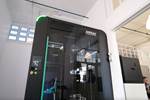Is Automation More Effective Than Size for Serial Production 3D Printing?
Micro Factory has developed an mSLA system that incorporates cleaning, curing and part ejection, not to mention 100 empty build plates, into the frame of a desktop machine. The result is a small unit for large-scale production.
When stereolithography or SLA 3D printing moves from prototyping to repetitive part production, what is the right way to achieve this quantity increase? One approach is to employ a larger SLA machine offering the build surface for a larger number of parts. But Leonard Krebs, chief technology officer with Micro Factory, points out the drawback: That large machine still needs an operator or technician to take the parts 3D printed in this way to the downstream steps, namely cleaning and curing, that stereolithography requires. His company, a startup based in Munich, Germany, has developed a different approach. Micro Factory’s production 3D printer remains small — desktop size — but it incorporates all the downstream steps into the machine for a more fully automated process.
“People want to use SLA because the quality is so good, but they stop because they don’t want to wear gloves and deal with resin,” Krebs says. The self-contained Micro Factory unit minimizes this kind of interaction. Polymer components can leave the machine complete.

The self-contained Micro Factory unit, as seen at Formnext. The desktop machine is an mSLA 3D printer that also incorporates postprocessing steps as part of the automated cycle. Cloud-based software from the same provider enables distributed production across multiple units like this.
The 3D printer is a masked stereolithography system, or mSLA, meaning instead of a laser it uses shape projection on an LCD screen to form each layer. The available build volume is 198 × 123 × 200 mm. Under the machine’s 3D printing head, a resin vat and a cleaning station are both contained within the machine’s frame. Precisely how all of these elements move within the system, so that parts proceed seamlessly from printing to cleaning to curing, is detail the inventors wish to keep secret until the machine is fully commercialized. One of the considerations the design masters is effectively guarding the resin vat within this automated cycle, so unused resin is not affected by the postprocess curing of the printed and cleaned parts.
The intent of the integrated system is ongoing, unattended production — or high volume out of a small footprint. The machine holds up to 100 build plates at a time, so when a job is finished, the build plate is ejected from the machine on angled tracks (perhaps going to a rack, conveyor or robot station) as the next empty build plate loads. Slicing and job management software is cloud-based for integration of multiple Micro Factory machines, allowing jobs to be sent to any unit available, including in separate locations.
The machine was first seen at Formnext 2023, and Krebs says the company is preparing for sales and delivery starting in 2024.
Related Content
-
NanoOne Green 3D Printer Offers Increased Precision, Ability to Work With Broad Range of Materials
Formnext 2024: The printer features UpNano’s adaptive resolution technology, which dynamically expands the width of the laser beam tenfold to speed up printing in bulk material areas or shrinks it where precision is needed.
-
Q&A With Align EVP: Why the Invisalign Manufacturer Acquired Cubicure, and the Future of Personalized Orthodontics
Align Technology produces nearly 1 million unique aligner parts per day. Its acquisition of technology supplier Cubicure in January supports demand for 3D printed tooling and direct printed orthodontic devices at mass scale.
-
Fizik Utilizes Carbon DLS Technology for One-to-One Program, Creating Customized Bike Saddles
Fizik’s customized bike seat program uses Carbon’s Digital Light Synthesis technology and personalized rider data to create a line of truly custom saddles, giving bike riders the best bike seat for their posterior — only made possible through additive manufacturing.














